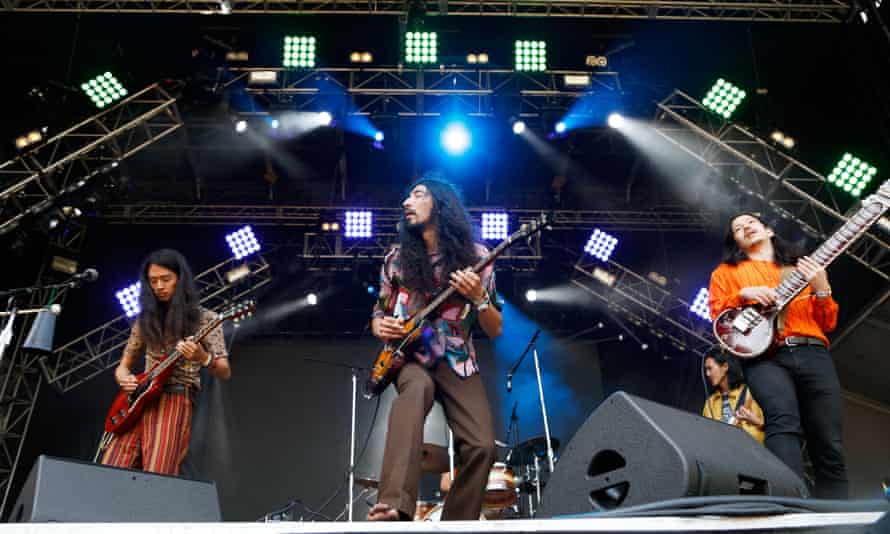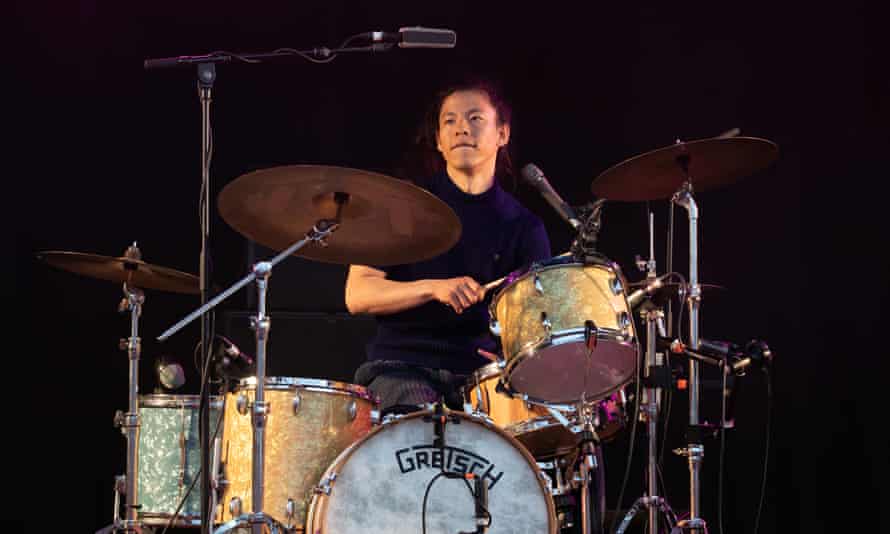When we think of psychedelic music, we think of the Jimi Hendrix Experience, the 13th Floor Elevators, blurry images from Woodstock. But for Japanese band Kikagaku Moyo, psychedelia is exemplified by their nation’s countercultural heroes Acid Mothers Temple with their cauldron of intense fuzz, and Flower Travellin’ Band. Go Kurosawa, the frontman of Kikagaku Moyo, also cites present-day Tokyo. “The music, the cinema, the culture, the freedom in not having to be technically perfect or be restricted. Our psychedelia doesn’t come from the hippy scene, it’s in nature, it’s in the chants you hear at the temple. Watching people board the train every day? That’s psychedelic.”
The dynamic energy of a Kikagaku Moyo live show – one in which the long-haired members of the band often digress into 10-minute long jams – stems from Takadanobaba, a college neighbourhood in the Shinjuku ward of Tokyo in the early 2010s. Drifting between vintage stores, bars populated by college students, and recording studios open late into the night, the quintet formed, and today, thanks to near-levitating live performances and spellbinding albums, they’re at the forefront of Japanese rock music. But after the release of their fifth album, Kumoyo Island, Kikagaku Moyo are breaking up, after an international farewell tour: an explicitly un-American choice to avoid continuing, and possibly diluting, what they’ve created.
Kurosawa and Tomo Katsurada first met in 2012. The name Kikagaku Moyo translates as geometric patterns. “We would jam so much from midnight to 6am that by the time we would pass out, we would see these geometric patterns in our eyelids,” Katsurada says. Kurosawa’s younger brother Ryu returned from India having trained on the sitar, bassist Kotsu Guy and guitarist Daoud Popal joined soon after, with Kurosawa on drums and Katsurada on guitar, the two trading vocals. Their early jam sessions were defined by the group’s varied tastes in old school hip-hop, metal, Indian classical, blues and more. Their inexperience helped the band stay free, their sound nebulous: ambient stoner rock with loops, retro-fuzz guitar and sweeping sitar.
On their second record Forest of Lost Children, which goes from the unstudied jam of Semicircle to the bluesy guitar of Kodama, followed by feverish sitar in their cover of Ananda Shankar’s Streets of Calcutta and sombre melancholia in White Moon, a pattern emerged that Kikgaku Moyo would repeat with each subsequent album: Kurosowa’s drums jumpstart a crescendo that builds and then settles into a meditative close.
“We don’t have many lyrics because we want to give people the space to imagine their own journey with the music. Each album is like a movie,” Katsurada says. Kumoyo Island feels like a journey in solitude through a vast expanse. . “When I’m making music, I’m first trying to make a playground for the five of us to enjoy playing in,” Kurosawa says. “Adding words to it feels like a limitation to that imagination.”
Kumoyo Island “is influenced by the experience of touring, scenes from cars and stages, cultures that we experienced,” Katsurada says. After playing shows in Japan and Europe, Kikagaku Moyo made their American debut at Berlin, a dimly lit hole in the wall in New York City, where the stage is a small platform only a few inches above the ground. I was present for that performance, standing so close to the younger Kurosawa’s sitar that I could touch it. Since then, the venues have grown but their willingness to play around, to expand riffs and solos beyond imagination, to lull the audience into a collective psyche, endures. On stage, they’re hypnotic and funky, humorous and personable, playing long eardrum-shattering solos without wavering from a smile.
Once the album was complete, the decision to bid goodbye came to the band, like their music, instinctively. “We achieved everything we wanted to. We wanted to play psychedelic music festivals and tour the world, which we did. We poured time and energy into not just making music, but creating art, merchandise and a vision for what Kikagaku Moyo is. And we now get to complete our journey on our terms, on the highest note possible,” Kurosawa says.

The band is touring Europe this month – including Glastonbury – and then America, though their last show though will be at home, at the Fuji Rock festival: a complete circle. Katsurada and Kurosawa will return to their adopted base in Amsterdam, where they run Guruguru Brain, a record label committed to championing other esoteric acts. The band’s legacy remains enshrined, Katsurada says, in their “creative imperfection”. He signs off with a smile: “I hope we leave behind the space for the younger generation to take over. It doesn’t matter how much technical expertise they have or what corner of the world they came from. I hope that the message we have imparted is that it is possible for music to cross borders and language barriers.”

